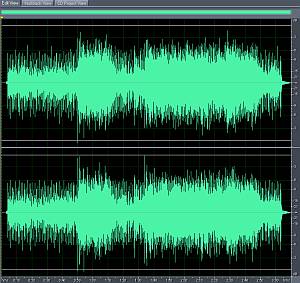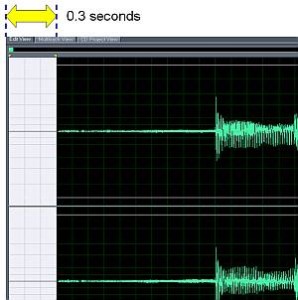How To Use Cool Edit Pro
Mastering with Cool Edit Pro/ Adobe Audition
This is a short guide on how to do mastering using Cool Edit Pro (now chosen Adobe Audition). Particularly, this is written based on older Adobe Audition ane.v. But I do believe the techniques outlined here tin also be applied to later Adobe Audition versions such equally Adobe Audition 3.
Mastering is the last stage of the audio product process, next to mixing. So make sure that before you start mastering, your audio wave must pass the following backdrop:
1.) Information technology is a mix down wave. This is single waveform, which is summation or the final result of the mixing process. It should simply be one waveform but containing all musical instruments mix (vocals, drums, guitars, etc). Meet examples below:

Sample photo of the audio mixdown afterward mixing process
ii.) No EQ and Pinch is still practical. It should be completely fresh, the single waveform is withal Non being adjusted with any mastering EQ and compression settings.
iii.) The maximum summit of the audio wave (Peak amplitude) should non exceed -3dB. An allowance is needed for EQ and Pinch adjustments in mastering. If the wave is already peaking at the loudest level (0dB), then in that location is no room for EQ and Compression adjustments.
Information technology is a adept practice in mixing that the completed mix down should accept some headroom for EQ/mastering adjustments. You can mensurate the meridian aamplitude by going to Edit View –> Analyze –> Statistics.
For details, read this tutorial on the specifications of your sound mix required earlier mastering.
Step1. Trimming of start and ending. I give a 0.three second allowance before the beginning of the audio wave and 0.6 2nd allowance at the end of the moving ridge. If the moving ridge exceeds 0.3 second from the moment it started playing, cutting it. Below is the sample screenshot of the trimmed wave at the start (it was exceeding 0.iii seconds earlier and I cut it to 0.3 seconds standard).

Start of the audio moving ridge trimming
Step2. EQ phase – The objective of EQ stage is to shape the final sound of the recording, utilize presence, boost howdy frequencies and lows also as removing muddiness.
Use the Adobe Audition Parametric Blaster to arrange settings. You tin also apply EQ plugins similar those from Moving ridge. Refer to this post-obit expert tutorial on mastering EQ using Audition:
EQ Settings for Mastering
How to utilise a parametric blaster
Step3. Pinch phase – The overall objective of the compression stage is to make the audio wave equally loud every bit possible without creating distortion. In this case, I am using the L2 Waves plug-in for Adobe Audition one.5:
Go to Effects –> DirectX –> Waves –> L2 and arrange the post-obit:
Under mill preset change to: Hi Res CD Master then adjusts the following:
Threshold: -7.5
Out of Ceiling: 0.two
Click OK, this will maximize the volume of the recording to around -13dB (average RMS power) which is considered OK for chief recordings. You can check the loudness in terms of average RMS power past Analyze –> Statistics.
Fine tune the mastering and use your ear. You lot can use this technique to call back your settings in the mastering FX concatenation.
Behave in mind that mastering in Adobe Audience is a destructive sound editing process, so make certain y'all have backup the original mix before y'all go along.
This website uses cookies to amend your feel. We'll presume you're ok with this, simply you can opt-out if you wish.Accept Read More
Source: https://www.audiorecording.me/mastering-with-cool-edit-pro-adobe-audition.html

0 Response to "How To Use Cool Edit Pro"
Post a Comment